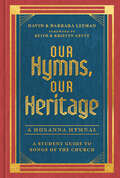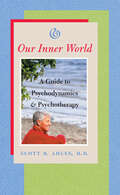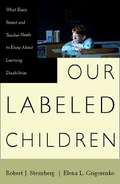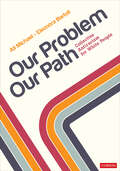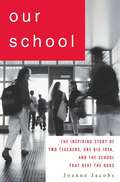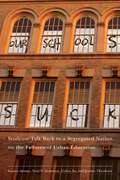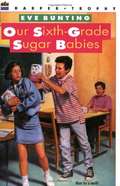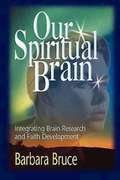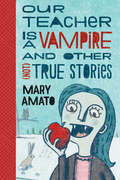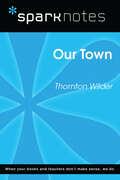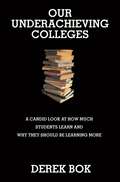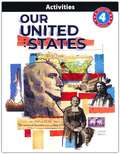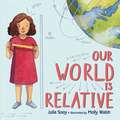- Table View
- List View
Our Hymns, Our Heritage: A Student Guide to Songs of the Church
by David Leeman Barbara LeemanOur Hymns, Our Heritage encourages a love and appreciation for the church&’s hymns—a significant way to pass the Christian faith from generation to generation. The book features music and lyrics for 121 hymns that every person should know, drawn from a cross-section of styles, themes, and historical eras. The hymns are divided into sections based on the church year, God&’s nature and attributes, and our responses to Him. Each hymn is presented on single book spread—the left-hand page gives a brief biography of the text&’s author and the melody&’s composer as well as a devotional summary to aid singing with understanding. The right-hand page is hymnal-like with the music and stanzas for simple playing and singing. Our Hymns, Our Heritage can be used by parents and educators alike to instill a life-long love for the richness and beauty of hymns.
Our Hymns, Our Heritage: A Student Guide to Songs of the Church
by David Leeman Barbara LeemanOur Hymns, Our Heritage encourages a love and appreciation for the church&’s hymns—a significant way to pass the Christian faith from generation to generation. The book features music and lyrics for 121 hymns that every person should know, drawn from a cross-section of styles, themes, and historical eras. The hymns are divided into sections based on the church year, God&’s nature and attributes, and our responses to Him. Each hymn is presented on single book spread—the left-hand page gives a brief biography of the text&’s author and the melody&’s composer as well as a devotional summary to aid singing with understanding. The right-hand page is hymnal-like with the music and stanzas for simple playing and singing. Our Hymns, Our Heritage can be used by parents and educators alike to instill a life-long love for the richness and beauty of hymns.
Our Inner World: A Guide to Psychodynamics and Psychotherapy
by Scott R. AhlesMental health practitioners and students learning psychodynamic psychotherapy are often exposed to multiple schools of thought—Freudian theory, interpersonal theory, ego theory, object-relations theory, self-psychology, and affect theory. In this book, Scott Ahles introduces and explains the major theories and integrates them into a model of psychodynamics that can be used to treat common psychiatric complaints. After explaining the theories, Ahles, applies an integrated approach to two general areas of patient discomfort: problems with sense of self, such as anxiety, depression, low self-esteem, and feelings of worthlessness; and problems with interpersonal relationships, such as difficulty forming long-term relationships, excessive shyness or fear of others, and aggressive personality. The psychotherapy of both problems of sense of self and interpersonal relationships are discussed and illustrated with clinical cases. Ahles also discusses the psychodynamic model in relation to neurobiological research into brain function, and he explores how psychotherapy can best be combined with pharmacotherapy. Throughout, the primary concepts of object relations and ego psychology are demonstrated with diagrams and case studies. A valuable tool for teaching concepts to students of psychiatry, psychology, social work, and general medicine, Our Inner World allows the future clinician to keep various psychodynamic aspects of the patient in mind during treatment.
Our Labeled Children: What Every Parent and Teacher Needs to Know About Learning Disabilities
by Robert J. Sternberg Elena L. GrigorenkoSternberg and Grigorenko, both psychologists and researchers at Yale University, are concerned that the way learning disabilities are assessed and treated in American school systems is not consistent. They argue that everyone is learning disabled in something, but that society only chooses to recognize disabilities in certain areas. They also note that lumping all children labeled learning disabled into this one category actually harms most of the children because they do not all have the same needs. The authors suggest that instead of this one form of remediation, the schools should develop a system through which the needs of each child are met on an individualized basis.
Our Problem, Our Path: Collective Antiracism for White People
by Ali Michael Eleonora BartoliA healthy multiracial society could be ours Building a healthy multiracial society is possible, but not without millions of White people seeing racism as our problem and choosing to walk an antiracist path. It will take us supporting and challenging one another on this journey to learn more about the realities of racism and what we can do about it. In Our Problem, Our Path, award-winning author Ali Michael and clinical psychologist Eleonora Bartoli invite White people to join them on an antiracist journey to learn to talk about race with one another in ways that lead to real change. Drawing on decades of personal and professional experiences engaging in antiracism, the authors: emphasize the need for White people to have honest, meaningful relationships not only with People of Color and Native people, but also with other White people, in order to change systems shaped by racism provide strategies for parents and teachers to support White children to become contributing members of a healthy multiracial society introduce trauma-informed tools from psychology that enable readers to understand and overcome their own resistance and fear around taking antiracist action demonstrate how White people can take antiracist action today, exactly where they are and as they are Grounded in an understanding of antiracism as a daily, lifelong practice, Our Problem, Our Path supports White people to help one another find the trailhead and start moving on the path toward a more just, equitable and loving multiracial society for all.
Our Problem, Our Path: Collective Antiracism for White People
by Ali Michael Eleonora BartoliA healthy multiracial society could be ours Building a healthy multiracial society is possible, but not without millions of White people seeing racism as our problem and choosing to walk an antiracist path. It will take us supporting and challenging one another on this journey to learn more about the realities of racism and what we can do about it. In Our Problem, Our Path, award-winning author Ali Michael and clinical psychologist Eleonora Bartoli invite White people to join them on an antiracist journey to learn to talk about race with one another in ways that lead to real change. Drawing on decades of personal and professional experiences engaging in antiracism, the authors: emphasize the need for White people to have honest, meaningful relationships not only with People of Color and Native people, but also with other White people, in order to change systems shaped by racism provide strategies for parents and teachers to support White children to become contributing members of a healthy multiracial society introduce trauma-informed tools from psychology that enable readers to understand and overcome their own resistance and fear around taking antiracist action demonstrate how White people can take antiracist action today, exactly where they are and as they are Grounded in an understanding of antiracism as a daily, lifelong practice, Our Problem, Our Path supports White people to help one another find the trailhead and start moving on the path toward a more just, equitable and loving multiracial society for all.
Our School
by Joanne JacobsHonest, engaging, and inspiring, Our School tells the story of Downtown College Prep, a public charter high school in San Jose that recruits underachieving students and promises to prepare them for four-year colleges and universities. The average student enters ninth grade with fifth-grade reading and math skills. Many have slid through school without doing homework. Some barely speak English. Tracking the innovative and pioneering program, award-winning journalist Joanne Jacobs follows the young principal who tries to shake the hand of every student each day, the dedicated teachers who inspire teens to break free from their histories of failure, and the immigrant parents who fight to protect their children from gangs. Capturing our hearts are the students who overcome tremendous odds: Roberto, who struggles to learn English; Larissa, a young mother; Pedro, who signals every mood change with a different hair cut; Selena, who's determined to use college as her escape from drudgery; the girls of the very short, never-say-die basketball team; and the Tech Challenge competitors. Some will give up on their dreams. Those who stick with the school will go on to college. This gritty yet hopeful book provides a new understanding of what makes a school work and how desire, pride, and community--ganas, orgullo, and communidad--can put students on track for success in life.
Our School (Places in Our Community)
by Lisa J. AmstutzSchools are busy places! Lots of community helpers are needed to make a school run smoothly. Readers will learn about who works at a school, what the workers do, and what makes a school special. Simple, at-level text and vibrant photos help readers learn all about schools in the community.
Our Schools Suck: Students Talk Back to a Segregated Nation on the Failures of Urban Education
by Jeanne Theoharis Gaston Alonso Noel S. Anderson Celina SuShares the voices of students speaking out against the failures of urban education"Our schools suck." This is how many young people of color call attention to the kind of public education they are receiving. In cities across the nation, many students are trapped in under-funded, mismanaged and unsafe schools. Yet, a number of scholars and of public figures have shifted attention away from the persistence of school segregation to lambaste the values of young people themselves. Our Schools Suck forcefully challenges this assertion by giving voice to the compelling stories of African American and Latino students who attend under-resourced inner-city schools, where guidance counselors and AP classes are limited and security guards and metal detectors are plentiful—and grow disheartened by a public conversation that continually casts them as the problem with urban schools.By showing that young people are deeply committed to education but often critical of the kind of education they are receiving, this book highlights the dishonesty of public claims that they do not value education. Ultimately, these powerful student voices remind us of the ways we have shirked our public responsibility to create excellent schools. True school reform requires no less than a new civil rights movement, where adults join with young people to ensure an equal education for each and every student.
Our Sixth Grade Sugar Babies
by Eve BuntingVicki Charlip and her friend Ellie are humiliated! Their sixth-grade teacher, Mrs. Oda, says each of her students must dress a five-pound bag of sugar in baby's clothes and carry it around. For a whole week they must never leave their sugar babies alone. It will teach them responsibility. "How will you know if we cheat?" Horrible Harry Hogan asks. "I'm putting you on your honor," Mrs. Oda says. Vicki is sure Horrible Harry will cheat, but of course she won't. But then a gorgeous seventh-grade boy moves in across the street, and Vicki is embarrassed to have HIM see her carrying around a silly-looking sugar baby. One deception leads to another when Vicki abandons her baby temporarily, and the baby vanishes. Horrors! Has it been stolen and turned into cookies? Or worse, into fudge? It is not, however, until there is another disappearance and a near-tragedy that Vicki learns the true meaning of responsibility... and honor.
Our Spiritual Brain: Integrating Brain Research and Faith Development
by Barbara BruceBrain research is about making discoveries. It is about learning how this most amazing organism works and how it influences every aspect of your life. As religious educators, you need to know how the brain functions and how to translate that information into better, more usable lessons to help students continue, with depth and purpose, on their journey of faith. The first section of this book is a brief background of the brain research that is fascinating so many people in so many fields today. The second section is about learning, particularly brain-based learning. The third section is divided into twelve segments. Each segment is a practical application to Christian education based on the findings in brain research. The fourth section will help you to take your learning about the brain into new areas of discovery.
Our Teacher Is a Vampire and Other (Not) True Stories
by Mary Amato Ethan LongIt all begins when Alexander H. Gory Jr. passes around a notebook in which he reveals a tantalizing secret: he has proof that their teacher, Mrs. Penrose, is a vampire. Soon the entire class is speculating and adding their opinions to the notebook until . . . it lands in Mrs. Penrose's hands. It turns out that Mrs. Penrose has been keeping a secret: she is expecting a baby. But since the notebook is encouraging her students to write and improving their spelling and grammar, Mrs. Penrose allows it to continue circulating.The notebook becomes a place for jokes, poems, and stories. When Mrs. Penrose's baby comes too soon, she is replaced by a no-nonsense substitute. Now, the students express their fears, frustrations and hopes.
Our Town (SparkNotes Literature Guide Series)
by Thornton Wilder SparkNotesOur Town (SparkNotes Literature Guide) by Thornton Wilder Making the reading experience fun! Created by Harvard students for students everywhere, SparkNotes is a new breed of study guide: smarter, better, faster. Geared to what today's students need to know, SparkNotes provide: *Chapter-by-chapter analysis *Explanations of key themes, motifs, and symbols *A review quiz and essay topics Lively and accessible, these guides are perfect for late-night studying and writing papers
Our Underachieving Colleges: A Candid Look at How Much Students Learn and Why They Should Be Learning More - New Edition (The William G. Bowen Series #46)
by Derek BokDrawing on a large body of empirical evidence, former Harvard President Derek Bok examines how much progress college students actually make toward widely accepted goals of undergraduate education. His conclusions are sobering. Although most students make gains in many important respects, they improve much less than they should in such important areas as writing, critical thinking, quantitative skills, and moral reasoning. Large majorities of college seniors do not feel that they have made substantial progress in speaking a foreign language, acquiring cultural and aesthetic interests, or learning what they need to know to become active and informed citizens. Overall, despite their vastly increased resources, more powerful technology, and hundreds of new courses, colleges cannot be confident that students are learning more than they did fifty years ago. Looking further, Bok finds that many important college courses are left to the least experienced teachers and that most professors continue to teach in ways that have proven to be less effective than other available methods. In reviewing their educational programs, however, faculties typically ignore this evidence. Instead, they spend most of their time discussing what courses to require, although the lasting impact of college will almost certainly depend much more on how the courses are taught. In his final chapter, Bok describes the changes that faculties and academic leaders can make to help students accomplish more. Without ignoring the contributions that America's colleges have made, Bok delivers a powerful critique--one that educators will ignore at their peril.
Our World Is Relative
by Julia SooyA fun and engaging picture book from author Julia Sooy and illustrator Molly Walsh explaining Einstein's theory of relativity.Size, speed, weight, direction, distanceWe think of space and time as fixed and measurable.But these measurements—our experience of space and time—they are relative.Our world is relative.With simple, engaging text and vibrant art imbued with light and movement, Our World Is Relative offers a child's-eye view of time, space, and the vast role that relativity plays in comprehending our world. It's an introduction to Albert Einstein's theory of relativity, perfect for any curious young scientist.Longlisted for the American Association for the Advancement of Science/ Subaru Children's Science Picture Book Award
Our World Through English class 10 - Andhra Pradesh Board
by Sri Navuluri Peraiah Sri Y.G.K.Murthy Sri K.Venkata Rama Rayudu Sri G.Sreenivasa Rao Dr. T.T.P. Mohan Babu Smt. K.Indira Sri K. Srinivas Reddy Sri Ch. Pradyumna Kumar Sri K. Ramesh Rao Sri V. Johnson Sri K.Janaki Ramaiah Smt G. Rajanikantha Kumari‘Our World through English’ Class X has been prepared in accordance with the syllabus for a ten-year course in English as a second language. Hoping you would supplement this textbook with some other material of your choice for effective classroom transaction. The text book contains 8 Units containing 3 units each. The book aims at improving proficiency in the use of English language. The overall aim of the textbook is to make you proficient users of English.
Our World Through English class 6 - Andhra Pradesh Board
by ApscertThis is the text book prescribed for English subject to the students of 6th class in Andhra Pradesh.
Our World Through English class 6 - Telangana Board
by TscertThis is the text book prescribed for English to the students of 6th class in Telangana.
Our World Through English class 8 - Andhra Pradesh Board
by Text Book Development CommitteeThis is the text book prescribed for English to the students of 7th class in Andhra Pradesh.
Our World Through English class 8 - Andhra Pradesh Board
by Textbook Development CommitteeThis is the text book prescribed for English to the students of 8th class in Andhra Pradesh.
Our World Through English class 8 - Telangana Board
by Textbook Development CommitteeThis is the text book prescribed for English to the students of 8th class in Telangana.
Our World Through English class 9 - Andhra Pradesh Board
by Textbook Development CommitteeThis is the text book prescribed for English to the students of 9th class in Andhra Pradesh.
Our World Through English class 9 - Telangana Board
by Textbook Development CommitteeThis is the text book prescribed for English to the students of 9th class in Telangana.
Our World through English class 8 - Telangana Board
by Textbook Development CommitteeThis is the text book prescribed for English subject to the students of 7th class in Telangana.
